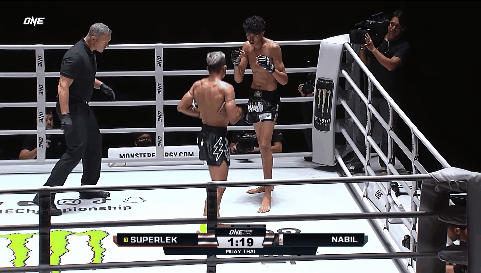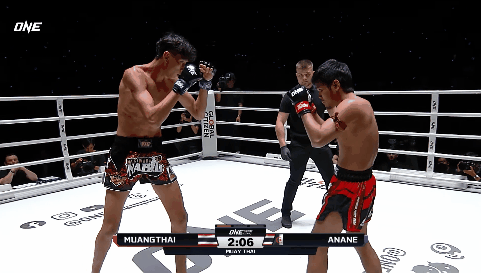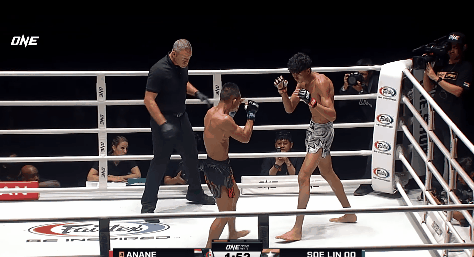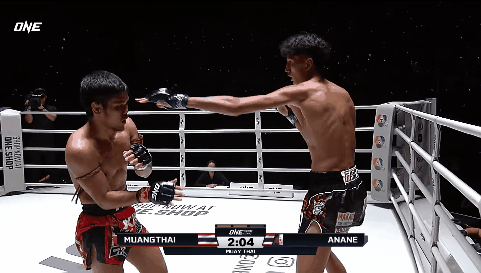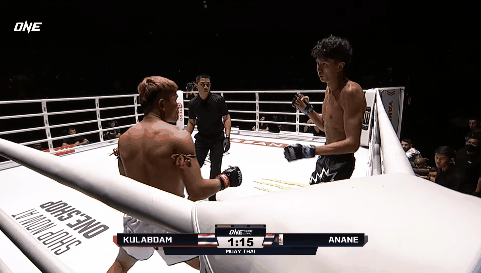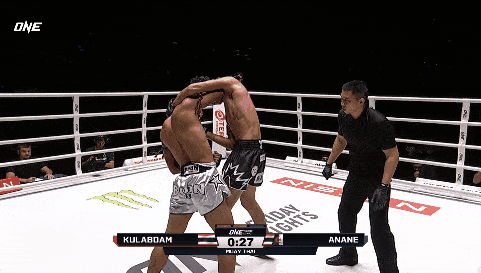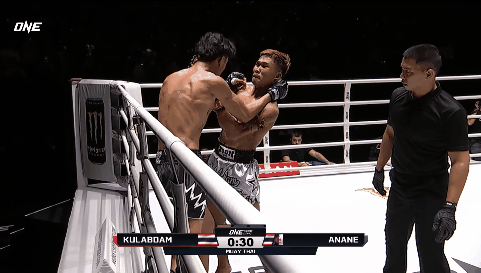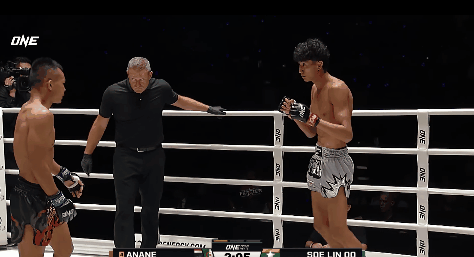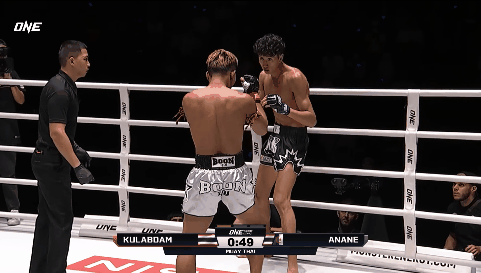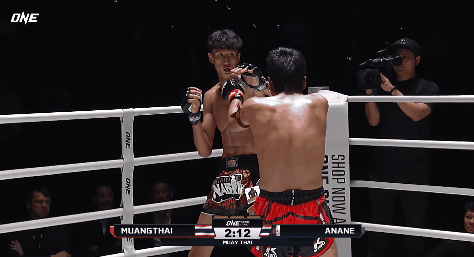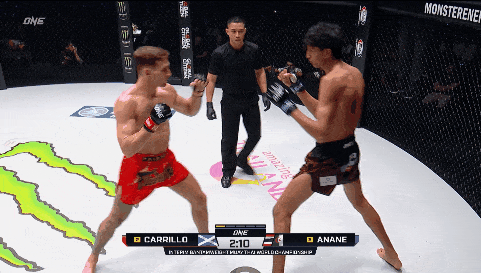Nabil Anane -
A Towering Nightmare
Even though Takeru and Rodtang are the marquee attraction on ONE Championship’s weekend mega-card, the eyes of the fighting world are firmly fixed upon Superlek vs Nabil Anane II.
Everything about this rematch oozes intrigue. Superlek is the finest striker in the world and has worked double time over the last few years, capturing and defending ONE’s kickboxing and four ounce Muay Thai titles. He has fought a rogues gallery of opponents under two completely different rulesets, and since a loss to Ilias Ennahachi in 2021, he has looked near untouchable. And yet, with the well-honed cynicism of longtime fight fandom, afficionados wait for the moment that the years and the fights finally catch up to Superlek. The tale of the tape reads just twenty-nine years old—a baby in boxing or mixed martial arts terms—but he won his first Lumpinee title and Fighter of the Year award back in 2012 and has been contending with the best fighters in the game for almost a decade and a half.
Then there is Nabil Anane. He is—struggling for a kinder word—a freak. At one hundred and forty five pounds, Nabil stands 6’4 and towers over everyone he meets. Curiously, while he has had opponents hospitalized and fights cancelled due to botched weight cuts, Nabil appears to have no trouble making the weight himself. In many ways, Nabil draws comparisons to the legendary golden age Nak Muay, Dieselnoi. Dieselnoi stood 6’2 and fought ten pounds lighter than Nabil, but when you see a towering beanpole chasing opponents down with knees that he lifts no higher than his belly-button, it is not hard to recall the single other time you witnessed it.
Recalling the first matchup between Superlek and Nabil, you might wonder why this one is getting so much buzz. Superlek dispatched the giant in just two minutes on that occasion. But revisit the fight and you will see that everything that seemed like it might give Superlek pause, did in fact give him trouble. His low kicks whiffed and Nabil returned with hard counters.
He was forced to punch and teep a foot higher than normal. Nabil’s jab could hit him from across the ring, and Nabil’s elbow hit him any time Superlek was close enough to land a solid punch.
One thing that is notable about Superlek beyond his technique, chin and power, is that he can adapt in a way that you can only hope to see from one of the greats. He realized it was not the time for finesse and immediately went to work running Nabil into the corner. Superlek quickly feinted a low kick and pumped a one-two to back Nabil all the way back to the ropes.
Superlek chased him all the way down to the other corner, and hit him with a terrific right straight to the body that put Nabil down for the count. It was masterful, and it went down as “TKO – R1 (2:03)”, but it was a moment of sheer opportunism from a man who for the most part doesn’t lose control of a minute of his fights.
And to add to the excitement, Nabil has only seemed to get better since. Nabil has run through Muangthai, Kulabdam, Felipe Lobo and Nico Carillo. All great fighters, and if he suffered ten good blows in all of those fights, Kulabdam landed maybe eight of them.
The Gift of Height
In striking sports, a tall frame is always acknowledged as an advantage. Reach is the measurement most fans fixate on, but a fighter’s effective range is really an interplay between height and reach. A fighter’s punch is at its longest when thrown level with the shoulder, and Nabil towers over his opponents in such a way that he must adopt a longer, lower stance order to not punch down on them.
Even adopting a longer stance you can watch Nabil score jabs on Muangthai, who throws back a long right low kick—aiming for the nearest target—and completely whiffs as Nabil slides his lead foot back.
As one of the youngest fighters finding great success in ONE Championships’ Muay Thai divisions, Nabil stands at a curious moment in the sport. Many of his peers are fighting in big gloves, over at Rajadamnern stadium and in Rajadamnern World Series—a more glamorous, modern take on traditional Muay Thai. ONE Championship has the run of Lumpinee stadium now, and its Muay Thai fights are fought in four ounce gloves. There have been great jabbers in Muay Thai in the big gloves, but there is no denying that sneaking a jab through with four ouncers is much easier. With height, reach, and range on the opponent, and just four ounces of padding surrounding his fist, Nabil is a menace with the jab.
Nabil also makes a great deal of use of his lead hand as a frame and long guard. Every weekend UFC fans end up arguing about “accidental” eye pokes and the lack of point deductions. I will say that Nabil often jabs with his palm onto the opponent’s forehead, holding them back like Tom used to restrain Jerry, and I haven’t seen him poke the eyes once.
The jab is the technique expected to benefit most from height and reach advantages, but I would argue you would have a hard time listing striking techniques that do not benefit from a height and reach advantage. In boxing it is traditionally thought that outside fighting is the property of the longer man, and inside fighting is the territory of the shorter fellow. In Muay Thai the knee and elbow make up for that window where the taller man’s punches will be smothered an awkward.
A tall man has an easier time with the stepping knee, and Nabil can often knee his opponents in the chin with little run up or telegraph.
Elbows, again, benefit from height. Just try elbowing a target half a foot above your head—it isn’t easy, and in the ring that target is elbowing back. Muangthai has as many elbow knockdowns and cuts as anyone you can think of, but he looked ridiculous trying to elbow Nabil even while standing right up against him.
The advantages Nabil has on all eight limbs can be seen in the variety of ways he has chosen to fight. Against Muangthai he hung back and let Muangthai kick ineffectively at his lead leg, often withdrawing it and returning with counter knees and kicks. For Felipe Lobo he focused on offensive flurries rather than drawing Lobo forward. Against Kulabdam he picked at the southpaw banger from the outside, and latched onto the double collar tie any time Kulabdam got close.
That double collar tie is another great example of how much fun it is to be freakishly tall for your weight in Muay Thai. The double collar tie is not a major feature of most Muay Thai fights, which disappointed a lot of MMA fans who saw Anderson Silva smash in two dozen knees from there on Rich Franklin and decided to check out this Thai boxing stuff. Pulling another human being’s head down into the path of your knee is obviously easier said than done. But when Nabil’s opponents close to infighting range, their head is already the right height for him to knee and he can slap on the double collar tie and simply use it to hold their forehead against his chest.
Watching Nabil arc this knee in over his opponent’s upper arm feels unfair. A young Masaaki Noiri could sneak knees through the same angle, but he had to jump.
There are supposed to be different weapons for different body types, but many of the “advantages” available to a shorter man come from being able to arc his punches in overhead at a closer range, or duck onto the opponents hips or achieve a bodylock more easily. While trips are technically legal in ONE Championship’s Muay Thai, the clinch does not play out for long, so achieving a bodylock does not offer you much except a brief respite. Rambaa Somdet used to almost exclusively knee the thighs from the clinch in stadium Muay Thai, as he so often conceded height to his opponents, but that is very much seen as time wasting in ONE Championship and you do not get much clinch time to begin with.
The overhand can still be an issue for Nabil. The real short man’s overhand is the Rocky Marciano punch I have heard called the “blind right.” The one where Rocky came in with his head low, looking at the centre of the opponent’s chest as if he were going to headbutt it, and then threw an overarm swing that smashed them on the temple and sent them to the mat. It can be especially useful when an opponent is reaching out to grab collar ties. Superlek did in fact land it against Nabil in their first fight in this way, and Kulabdam—while a southpaw—found a few good chances for overhand punches in the looser clinches in that fight.
The advantage on the level change doesn’t mean much for clinch work in a ONE Championship Muay Thai match, but maintains has the same advantage it does in boxing. A shorter man can use that quick level change to get in and punch the body—really punching into the body and not down at it. The right straight to the body that Superlek knocked Nabil out with in their first fight is the perfect example.
The moment Nabil hits the ropes, he not only becomes vulnerable to the in-tight overhand, but his long torso becomes an enormous target. Historically the longest, gangliest fighters have also been the most susceptible to body shots because they are almost always extremely lean and any bro scientist can look at them and say “there cannot be a lot in the way of their organs.”
Unlike a boxer or a striker in mixed martial arts, Nabil does not have to run like his arse is on fire the moment his heel touches the boundary. The clinch is a non-issue for him, and in fact preferred in a lot of cases because he gets the restart. Even if the opponent steps in to body punch or pitch the overhand, he has the intercepting counters of the knee and elbow which can be even more effective, even though he is on the back foot and in bad ring position.
He is generally aware that his opponent gets their best chance at him when he hits the ropes, and even before the first Superlek fight, his ringcraft was generally pretty good even if it was not always urgent. When Muangthai attempted to charge him to the ropes in the second and third round of their bout, Nabil was able to use his hands to waltz Muangthai around him, or even pivot out on a counter elbow.
Being the biggest guy in the ring all the time can often instill negative habits. Nico Carillo was called a weight bully for a long time, and developed one defensive reaction to everything: he leaned back when his opponent threw. When Carillo met Nabil, his defensive habits showed him up horribly. When he wasn’t the taller, longer fighter, Carillo suddenly had nowhere to go and was dropped with a long right straight as he leaned.
That is the difference. Nico Carillo’s size makes him difficult but at his heart he wants to have a tear up and his natural advantages give him a decent, if unfair boost. Nabil fights in a way where his size is all consuming. If you bet on the other guy you might end up sour because “he only wins because he is so tall,” but it is Nabil’s discipline in pushing that advantage in every second of every fight that makes that all you can see. Of course being tall doesn’t win you fights outright, but if you give a terrific fighter a foot of height over his opponents and he abuses it relentlessly, the height is all you are going to see.
Even looking at the Superlek knockout, Nabil is pushed to the ropes, Superlek surges in, and Nabil is timing a counter knee as Superlek level changes into the fight ending shot. And that is what made the first fight so much fun. Superlek was forced to fight in a way he does not usually. He was reckless, and he was in danger. To land fight changing shots he had to risk getting kneed or elbowed in the dome. Compare it to the Rodtang fight where he basically shut Rodtang’s offence down with hand trapping and barely ate a decent blow after round one.
David versus Goliath has always been a compelling story in combat sports, and it is in those bizarre mismatches of build that you sometimes get to see the real mastery of the craft of fighting come to the fore. All the trickery, all the psychology, all the experience of a lifetime of combat sports, used to turn the tide when the physical matchup is so stacked against the smaller man. But the part no one ever mentions about the scripture is that David never had to contend with a rematch.





